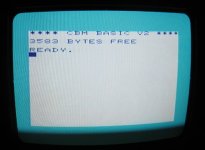tezza
Veteran Member
Hi,
I'm slowly reparing my (later-version) Vic-20. I've found out it actually has more than just one problem. First, I've found the 74LS04 chip was faulty, so it was replaced with a new socketed chip.
This stopped all the random bars and lockup, but I'm not out of the woods yet. The character colours are still all wrong. I strongly suspect one of the colour SRAM 2114 chips (at UE1) as this gets very hot.
Anyway, I have no source of these exact chips. However, I do have an old Vic motherboard Terry Yager gave me. It's the first version of the Vic, so it's not the same as mine. However, it does have a whole bank of 2114 chips.
The chips in the old board are stamped MM2114N-3L (used for the 4k RAM)
The chips in the newer Vic are stamped MM2114P25 (used for Colour control somehow)
My question is, are these interchangable? If so, I'll just whip on out of the old board and use it in the newer one.
I suspect they are not interchangable as they seem to perform a slightly different function (In this newer board, conventional RAM is facilitated by two large chips). Maybe the 2114s are interchangable though?
Do any chip jockeys out there know?
I'm slowly reparing my (later-version) Vic-20. I've found out it actually has more than just one problem. First, I've found the 74LS04 chip was faulty, so it was replaced with a new socketed chip.
This stopped all the random bars and lockup, but I'm not out of the woods yet. The character colours are still all wrong. I strongly suspect one of the colour SRAM 2114 chips (at UE1) as this gets very hot.
Anyway, I have no source of these exact chips. However, I do have an old Vic motherboard Terry Yager gave me. It's the first version of the Vic, so it's not the same as mine. However, it does have a whole bank of 2114 chips.
The chips in the old board are stamped MM2114N-3L (used for the 4k RAM)
The chips in the newer Vic are stamped MM2114P25 (used for Colour control somehow)
My question is, are these interchangable? If so, I'll just whip on out of the old board and use it in the newer one.
I suspect they are not interchangable as they seem to perform a slightly different function (In this newer board, conventional RAM is facilitated by two large chips). Maybe the 2114s are interchangable though?
Do any chip jockeys out there know?


